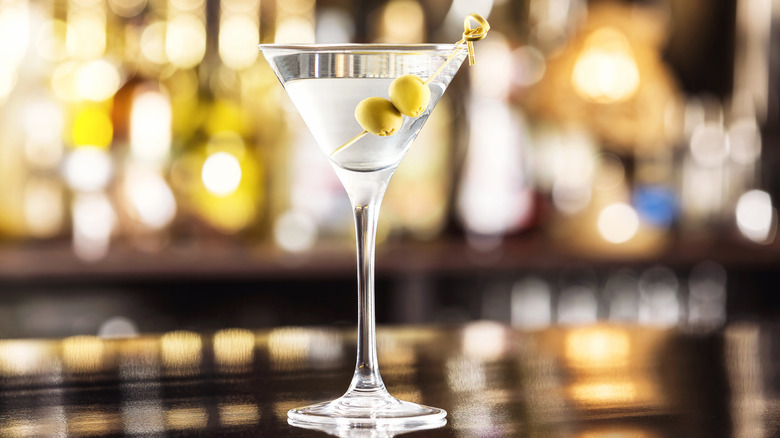The Key Ingredients That Make Up The Original Martini
Loved by everyone from British secret agents to F. Scott Fitzgerald to Humphrey Bogart, no wonder the martini cocktail has a reputation for sophisticated urbanity (via The Martini Hour).
Complete with its iconic v-shaped glass, it's the kind of timeless drink that conjures everything from swinging speakeasies to old-school Hollywood glamour. Pour a martini, and suddenly, the spirit of jazz bars, scarlet lipstick, and witty banter has entered your living room. But where exactly did the martini cocktail come from?
This drink's history is a little blurry — it seems that martini likes to hold its secrets close. As explained by Difford's Guide, it's probably an evolution of a Californian cocktail, the Martinez, that appeared around the 1860s (via Liquor.com.) According to Taste Cooking, some say it was invented by a barman in Martinez to celebrate a miner striking gold. And apparently, it may well have been created at Manhattan's The Knickerbocker hotel, being first served to John D. Rockefeller, per Conde Nast Traveler.
Over the years, different versions and expressions have appeared, including the vodka martini or imposters like the espresso martini. For this reason, there can be confusion about what a classic martini actually is. So what was the original recipe that launched 1000 sardonic sips?
How to make a classic martini
The original recipe featured gin, sweet Italian vermouth, orange bitters, and sugar syrup. Over the years, it's become stripped down to just dry French vermouth and gin or vodka. Yet as argued by Moody Mixologist, the aromatic orange bitters added a depth and nuance to the cocktail that the more gin-focused style has lost.
So how do you make a classic martini? As outlined by Epicurious, you will need 1 ½ ounces of London dry gin, 1 ½ ounces of sweet Italian vermouth, a dash of orange bitters, a teaspoon of sugar syrup, a small piece of lemon peel, and a green olive for garnish. To make it, swoosh the gin, vermouth, bitters, and syrup together in a cocktail shaker. Next, pour the mix into a martini glass, twist the lemon peel over it, pop the olive in, and voilà!
This recipe won't taste exactly like the original, as that used an 18th-century gin variety known as "Old Tom" (of Tom Collins fame). But as that's not always easy to source, the heavier, less sweet London dry is a decent replacement. And once you've mastered the classic martini recipe, you can experiment with ratios. As noted by European Bartender School, use less dry vermouth and keep the same amount of gin for a dry one; for a wet one, increase or double the vermouth.
You could even brave Ernest Hemingway's "Montgomery" martini, which, according to Codex 99, was served ice-cold with 15:1 gin to vermouth. Or you could try it "dirty," which requires a slosh of olive brine (via BBC Good Food) — but shhh, don't tell the martini purists.

